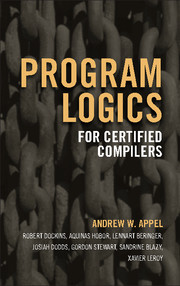Book contents
- Frontmatter
- Dedication
- Contents
- Road map
- Acknowledgments
- 1 Introduction
- I Generic separation logic
- II Higher order separation logic
- III Separation logic for CompCert
- IV Operational semantics of CompCert
- V Higher-order semantic models
- VI Semantic model and soundness of Verifiable C
- VII Applications
- Bibliography
- Index
I - Generic separation logic
Published online by Cambridge University Press: 05 August 2014
- Frontmatter
- Dedication
- Contents
- Road map
- Acknowledgments
- 1 Introduction
- I Generic separation logic
- II Higher order separation logic
- III Separation logic for CompCert
- IV Operational semantics of CompCert
- V Higher-order semantic models
- VI Semantic model and soundness of Verifiable C
- VII Applications
- Bibliography
- Index
Summary
Synopsis: Separation logic is a formal system for static reasoning about pointer-manipulating programs. Like Hoare logic, it uses assertions that serve as preconditions and postconditions of commands and functions. Unlike Hoare logic, its assertions model anti-aliasing via the disjointness of memory heaplets. Separation algebras serve as models of separation logic. We can define a calculus of different kinds of separation algebras, and operators on separation algebras. Permission shares allow reasoning about shared ownership of memory and other resources. In a first-order separation logic we can have predicates to describe the contents of memory, anti-aliasing of pointers, and simple (covariant) forms of recursive predicates. A simple case study of straight-line programs serves to illustrate the application of separation logic.
- Type
- Chapter
- Information
- Publisher: Cambridge University PressPrint publication year: 2014



